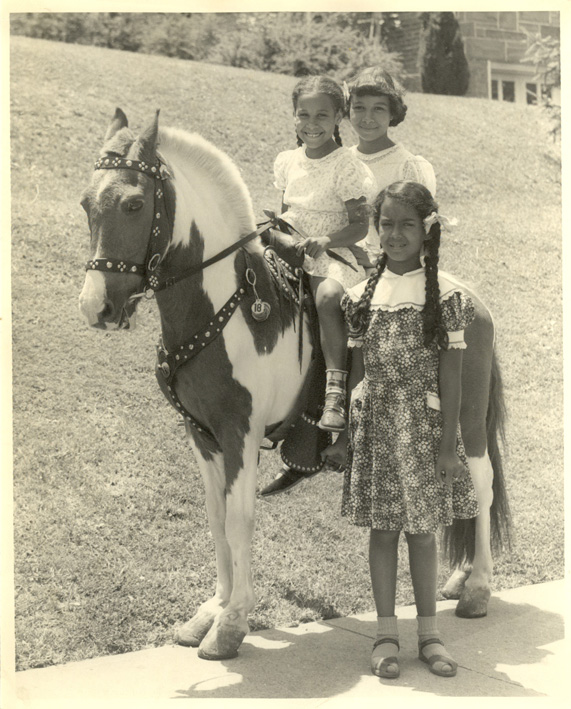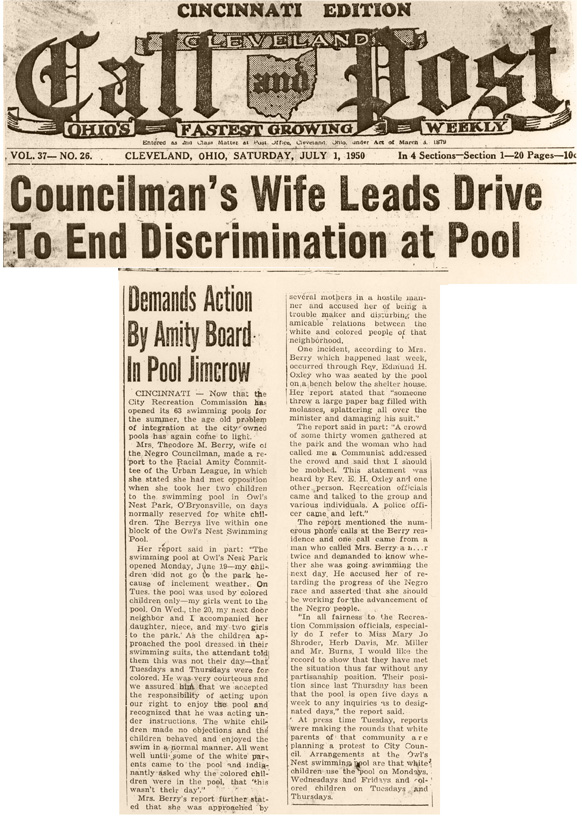By Laura Laugle
 Is there anything better on a hot summer’s day than splashing around in the pool with friends? Maybe adding ice cream and a beach ball or two to the mix would improve the day but the pool would still be the main event. In the summer of 1950 Faith and Gail Berry, aged eleven and seven respectively, considered themselves to be extremely fortunate – they lived on Fairfax Avenue in Walnut Hills just a block away from Owl’s Nest pool. I can see the girls now – their summertime plans probably closely mirroring my own and those of my classmates forty-some-odd years later. Chores would be done as quickly as possible so that the cool, dewy mornings could be spent playing kickball in the backyard and roller skating in the street with other neighborhood children. After lunch there would be the mad dash to change into swimming gear followed by what should be a short walk to the municipal pool made longer by those inexorable needs to find and drag sticks along sidewalks and fences and to inspect the various creepy crawlies found along the way. Finally, the heat of the afternoon sun would be softened by diving, dunking, swimming and splashing in the cool water. So it should be for all children. But for the Berry girls there was a problem.
Is there anything better on a hot summer’s day than splashing around in the pool with friends? Maybe adding ice cream and a beach ball or two to the mix would improve the day but the pool would still be the main event. In the summer of 1950 Faith and Gail Berry, aged eleven and seven respectively, considered themselves to be extremely fortunate – they lived on Fairfax Avenue in Walnut Hills just a block away from Owl’s Nest pool. I can see the girls now – their summertime plans probably closely mirroring my own and those of my classmates forty-some-odd years later. Chores would be done as quickly as possible so that the cool, dewy mornings could be spent playing kickball in the backyard and roller skating in the street with other neighborhood children. After lunch there would be the mad dash to change into swimming gear followed by what should be a short walk to the municipal pool made longer by those inexorable needs to find and drag sticks along sidewalks and fences and to inspect the various creepy crawlies found along the way. Finally, the heat of the afternoon sun would be softened by diving, dunking, swimming and splashing in the cool water. So it should be for all children. But for the Berry girls there was a problem.
Owl’s Nest pool, like most Cincinnati Pools of the time, was segregated. Although the Cincinnati Recreation Commission had never authorized it, Owl’s Nest had made Mondays, Wednesdays and Fridays “whites only” days and Tuesdays and Thursdays “coloreds only.” According to Gail Berry West, pictured above on a pony with her older sister Faith, the girls just couldn’t understand why they couldn’t  go to the pool. “We must have asked continually and finally our dear Mother had had enough of the asking.” So, on June 20, 1950 Johnnie Mae Berry and neighbor Mrs. Edmund Oxley took Faith, Gail and Mrs. Oxley’s daughter and niece to Owl’s Nest pool for a swim. Gail remembers “some white children were reluctantly pulled out of the water and others tried to stay in – much to their parents’ dismay. This continued on other white days when we went to the pool…” One incident which Gail remembers with particular horror is detailed in the article to the right. Rev. Edmund Oxley, then rector at St. Andrew’s Episcopal Church had molasses thrown on him. “That is what I remember was certainly distressing to us all. As children, we could not believe that someone could pour syrup on a man of God.”
go to the pool. “We must have asked continually and finally our dear Mother had had enough of the asking.” So, on June 20, 1950 Johnnie Mae Berry and neighbor Mrs. Edmund Oxley took Faith, Gail and Mrs. Oxley’s daughter and niece to Owl’s Nest pool for a swim. Gail remembers “some white children were reluctantly pulled out of the water and others tried to stay in – much to their parents’ dismay. This continued on other white days when we went to the pool…” One incident which Gail remembers with particular horror is detailed in the article to the right. Rev. Edmund Oxley, then rector at St. Andrew’s Episcopal Church had molasses thrown on him. “That is what I remember was certainly distressing to us all. As children, we could not believe that someone could pour syrup on a man of God.”
Of course, just as with all discriminatory practices which came before, all those which came after and all those which have yet to come, segregation at the pool could not last long once it was challenged by those brave enough to stand up for themselves. “I also remember some shouting, chanting, etc, but we children continued to swim and enjoy the water. My memory is that, of course, we continued to go again on “colored” days and “white” days and very soon, we were swimming with white children in the water and having a good time with all or so it seemed and the days were no longer considered white or colored days – but just days of the week when all could swim.”
In 2010, the University of Cincinnati Libraries received a $61,287 grant from the National Historical Publications and Records Commission of the Archives and Records Administration to fully process the Theodore M. Berry Collection in the Archives & Rare Books Library. All information and opinions published on the Berry project website and in the blog entries are those of the individuals involved in the grant project and do not reflect those of the National Archives and Records Administration. We gratefully acknowledge the support of NARA.


